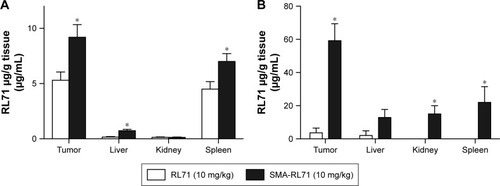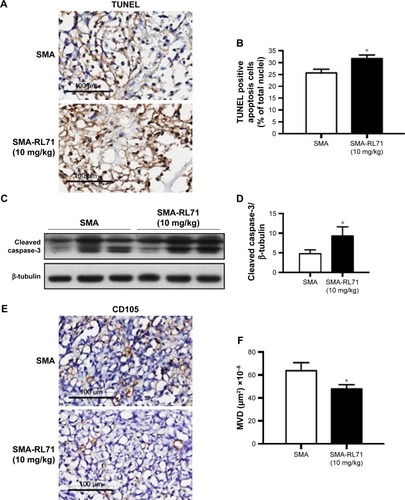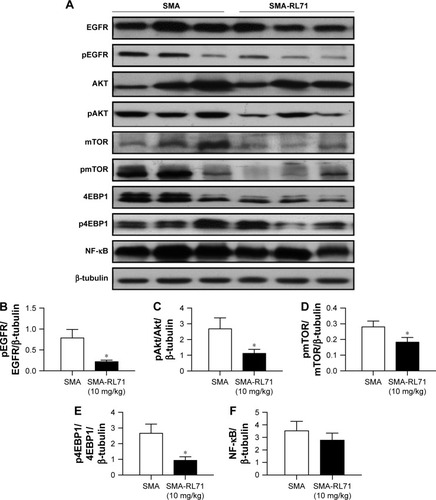Figures & data
Figure 1 Drug accumulation in tissues following treatment with RL71 and SMA-RL71.
Notes: Tumor-bearing mice were treated with (A) a single iv dose of 10 mg/kg of either RL71 or SMA-RL71 and euthanized 6 h later or (B) intravenously administered 10 mg/kg of RL71 or SMA-RL71 on days 4, 7, 11, and 14 and then euthanized 3 days later. Organs were processed for drug quantification by HPLC. Bars represent the mean ± SEM from five mice per group. Significance was determined with a one-way ANOVA and a Bonferroni post-hoc test. *Significantly different compared to the respective RL71 treatment group, p<0.03.
Abbreviations: ANOVA, analysis of variance; HPLC, high-performance liquid chromatography; iv, intravenous; RL71, 3,5-bis(3,4,5-trimethoxybenzylidene)-1-methylpiperidine-4-one; SMA, styrene maleic acid.

Figure 2 SMA-RL71 suppresses tumor growth in a xenograft model of TNBC.
Notes: Female SCID mice were implanted with MDA-MB-231 cells (1×106) and treated intravenously with (A) 10 mg/kg of SMA-RL71, RL71, or vehicle control twice a week for 2 weeks or with (B) 10 mg/kg of SMA-RL71 or SMA control twice a week for 3 weeks. The mice were euthanized on day 24. Symbols represent the mean ± SEM from eight mice per group. Significance was determined with a repeated-measures two-way ANOVA and a Bonferroni post-hoc test. *Significantly different compared to control, p<0.05.
Abbreviations: ANOVA, analysis of variance; RL71, 3,5-bis(3,4,5-trimethoxybenzylidene)-1-methylpiperidine-4-one; SCID, severe combined immunodeficient; SMA, styrene maleic acid; TNBC, triple negative breast cancer.

Figure 3 SMA-RL71 micelles increase apoptosis and decrease angiogenesis in TNBC xenograft tumors.
Notes: (A) Representative photomicrographs of TUNEL staining in tumor sections from treated mice. (B) Quantification of the number of TUNEL positive cells as a percentage of the total number of cells. (C) Representative blot of cleaved caspase-3 normalized to β-tubulin. (D) Scanning densitometry of Western blot for cleaved caspase-3. (E) Representative immunohistochemistry of CD105 staining from tumor sections of treated mice. (F) The number of CD105 positive endothelial cells in tumor sections from treated mice. Bars in each graph represent the mean ± SEM from eight mice per group. Significance was determined with a one-way ANOVA and a Bonferroni post-hoc test. *Significantly different compared to SMA control, p<0.05.
Abbreviations: ANOVA, analysis of variance; MVD, microvessel density; RL71, 3,5-bis(3,4,5-trimethoxybenzylidene)-1-methylpiperidine-4-one; SMA, styrene maleic acid; TNBC, triple negative breast cancer; TUNEL, terminal uridine nucleotide end-labeling.

Figure 4 Tumor protein expression levels of EGFR, Akt, mTOR, 4EBP1, and NF-κB following treatment with SMA-RL71.
Notes: Tumor-bearing mice were treated with SMA-RL71 (10 mg/kg, iv) or SMA control twice a week for 3 weeks. (A) Representative Western blots of the various proteins from individual mice. Scanning densitometry of Western blots of (B) EGFR, (C) Akt, (D) mTOR, (E) 4EBP1, and (F) NF-κB. Bars represent the mean ± SEM from eight mice per group. Significance was determined with a one-way ANOVA coupled with a Bonferroni post-hoc test. *Significantly different compared to SMA control, p<0.05.
Abbreviations: ANOVA, analysis of variance; 4EBP1, 4E-binding protein-1; Akt, protein kinase B; EGFR, epidermal growth factor receptor; mTOR, mechanistic target of rapamycin; NF-κB, nuclear factor-kappa B; RL71, 3,5-bis(3,4,5-trimethoxybenzylidene)-1-methylpiperidine-4-one; p4EBP1, phosphorylated 4EBP1; pAkt, phosphorylated Akt; pEGFR, phosphorylated EGFR; pmTOR, phosphorylated mTOR; SMA, styrene maleic acid.

Table 1 Subchronic toxicity of SMA-RL71 in Swiss Webster mice
Table S1 Indicators of animal health following treatment with SMA-RL71
